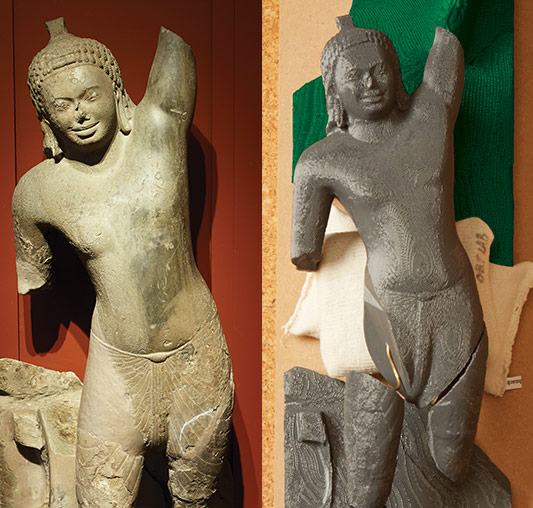launch
Sears think[box] Helps Solve Mystery at Cleveland Museum of Art
 PHOTO: KEVIN KOPANSKI
PHOTO: KEVIN KOPANSKINext steps: The digital scans from the Larry Sears and Sally Zlotnick Sears think[box] and decades-old photographs that recently came to light in Cambodia revealed that, despite best efforts, some statue pieces hadn't been re-attached at the correct angle during the 1970s--which helps explain why the fragment initially didn't fit with the statue. The Cleveland Museum of Art now plans to take apart the Krishna pieces, recombine them for a better fit and attach the fragment. The museum expects to complete and unveil the work within two years.
More about Krishna: The statue depicts Krishna as a youth in the act of miraculously and seemingly effortlessly holding up a hill to shelter villagers from a devastating and torrential downpour. The recently returned fragment is shown in green in this small-scale 3-D replica that rp+m in Avon Lake, Ohio, made using Sears think[box] scans.
It was an antiquities riddle decades in the making.
Did a 432-pound ancient stone fragment belong to a 1,400-year-old statue of Krishna, a revered Hindu deity, at the Cleveland Museum of Art (CMA)? Or had it, instead, broken away from a different Krishna sculpture, now in a Cambodian museum?
For decades, Cleveland and Cambodian curators had tried to solve the mystery. But it was only in the last year that they got the answer.
And the fellow sleuths who provided critical missing information work at the Larry Sears and Sally Zlotnick Sears think[box], the university's innovation hub.
The head and torso of CMA's Krishna statue were unearthed in southern Cambodia in 1912, and came to Cleveland in 1973 from a private collection in Brussels.
"This is an extremely important sculpture from the first major [archaeological] site of Cambodia," said Sonya Quintanilla, CMA's curator of Indian and Southeast Asian Art. "Of the eight sculptures found, six are in the National Museum of Cambodia, one is in Paris and then Cleveland. It speaks to our role as a leader on the world stage."
Soon after the acquisition, a CMA curator obtained several stone fragments that were from the same private collection and believed to be from the sculpture. Museum staff affixed the newly acquired feet and partial limbs. But, try as they might, they could not convincingly marry the 432-pound fragment—a back plate and left hand—with the 2,000-pound main sculpture. The sheer weight of the pieces alone impeded the process.
As a show of goodwill in 2005, the museum sent the fragment to the National Museum of Cambodia in Phnom Penh, where it was attached to another sculpture. But experts there weren't convinced they had the right fit, either.
When the fragment came to New York in 2014 as part of a special exhibition of loaned art from around the world, Quintanilla and colleagues—who still suspected the fragment belonged in Cleveland—had it scanned with 3-D imaging technology. Separately, they asked Sears think[box] to scan the CMA Krishna statue.
Staff at Sears think[box] spent more than a week scanning every inch of the statue and creating a complete digital file with millions of data points. "It was pretty cool," said Ben Guengerich (CWR '13), a design and manufacturing operations specialist at Sears think[box], who co-created the scans.
The aha moment took place at the Tinkham Veale University Center, where Quintanilla, Guengerich and others gathered in front of the two-story video wall, which doubles as a computer monitor. They watched with delight as the digital scans of the fragment and statue came together electronically on the giant screen.
"That's when I knew it was worth approaching the Cambodian government to try and get [the fragment] back," Quintanilla recalled. And return it the Cambodians did, convinced by modern technology.
"We never could have been sure that this piece belonged without the help of think[box]," Quintanilla said.





